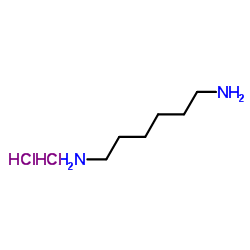1,6-Hexanediamine dihydrochloride

1,6-Hexanediamine dihydrochloride structure
|
Common Name | 1,6-Hexanediamine dihydrochloride | ||
|---|---|---|---|---|
| CAS Number | 6055-52-3 | Molecular Weight | 189.126 | |
| Density | N/A | Boiling Point | 205ºC at 760 mmHg | |
| Molecular Formula | C6H18Cl2N2 | Melting Point | 256-257 °C(lit.) | |
| MSDS | Chinese USA | Flash Point | 81.1ºC | |
| Symbol |

GHS07 |
Signal Word | Warning | |
|
Immobilization of phenylalanine dehydrogenase and its application in flow-injection analysis system for determination of plasma phenylalanine.
Appl. Biochem. Biotechnol. 163(2) , 258-67, (2011) Phenylalanine dehydrogenase (L-PheDH) from Sporosarcina ureae was immobilized on DEAE-cellulose, modified initially with 2-amino-4,6-dichloro-s-triazine followed by hexamethylenediamine and glutaraldehyde. The highest activity of immobilized PheDH was determi... |
|
|
Analysis of polyamines as carbamoyl derivatives in urine and serum by liquid chromatography-tandem mass spectrometry.
Biomed. Chromatogr. 22(1) , 73-80, (2008) A quantitative analysis of polyamines in urine and serum by liquid chromatography-tandem mass spectrometry (LC-MS/MS) is described. The polyamines were carbamylated with isobutyl chloroformate, extracted with diethyl ether under pH 9.0, and analyzed by LC-MS/... |
|
|
Receptor-based detection of 2,4-dinitrotoluene using modified three-dimensionally ordered macroporous carbon electrodes.
ACS Appl. Mater. Interfaces 4(9) , 4731-9, (2012) Detection of explosives, such as 2,4,6-trinitrotoluene (TNT), is becoming increasingly important. Here, 2,4-dinitrotoluene (DNT, a common analogue of TNT) is detected electrochemically. A receptor based electrode for the detection of DNT was prepared by modif... |
|
|
Enzymatically catalyzed conjugation of a biodegradable polymer to proteins and small molecules using microbial transglutaminase.
Methods Mol. Biol. 751 , 17-27, (2011) Hydroxyethyl starch (HES) is a water-soluble, biodegradable derivative of starch that is widely used in biomedicine as a plasma volume expander. Due to its favorable properties, HES is currently being investigated at the industrial and academic levels as a bi... |
|
|
Effects of long and short carboxylated or aminated multiwalled carbon nanotubes on blood coagulation.
PLoS ONE 7(7) , e38995, (2012) In this work the effects of four different multiwalled carbon nanotubes (MWCNTs), including long carboxylated (L-COOH), short carboxylated (S-COOH), long aminated (L-NH(2)) and short aminated (S-NH(2)) ones, on the integrity of red blood cells, coagulation ki... |
|
|
Response of Anastrepha suspensa (Diptera: Tephritidae) to terminal diamines in a food-based synthetic attractant.
Environ. Entomol. 37(5) , 1119-25, (2008) A current trapping system for Anastrepha fruit flies uses a two-component food-based synthetic attractant consisting of ammonium acetate and putrescine (1,4-diaminobutane). Development of more effective monitoring programs may be realized through identificati... |
|
|
Quantitative plasma biomarker analysis in HDI exposure assessment.
Ann. Occup. Hyg. 54(1) , 41-54, (2010) Quantification of amines in biological samples is important for evaluating occupational exposure to diisocyanates. In this study, we describe the quantification of 1,6-hexamethylene diamine (HDA) levels in hydrolyzed plasma of 46 spray painters applying 1,6-h... |
|
|
Effect of creatinine and specific gravity normalization on urinary biomarker 1,6-hexamethylene diamine.
J. Environ. Monit. 12(3) , 591-9, (2010) Urine amine levels used as biomarkers of diisocyanate exposure have usually been normalized with creatinine concentration. The suitability of using creatinine concentration or specific gravity for these biomarkers in exposure assessment has not been establish... |
|
|
Coating individual single-walled carbon nanotubes with nylon 6,10 through emulsion polymerization.
ACS Appl. Mater. Interfaces 1(8) , 1821-6, (2009) Solvent microenvironments are formed around individual single-walled carbon nanotubes (SWNTs) by mixing SWNT suspensions with water-immiscible organic solvents. These microenvironments are used to encapsulate the SWNTs with the monomer sebacoyl chloride. Hexa... |
|
|
Factors affecting variability in the urinary biomarker 1,6-hexamethylene diamine in workers exposed to 1,6-hexamethylene diisocyanate.
J. Environ. Monit. 13(1) , 119-27, (2011) Although urinary 1,6-hexamethylene diamine (HDA) is a useful biomarker of exposure to 1,6-hexamethylene diisocyanate (HDI), a large degree of unexplained intra- and inter-individual variability exists between estimated HDI exposure and urine HDA levels. We in... |